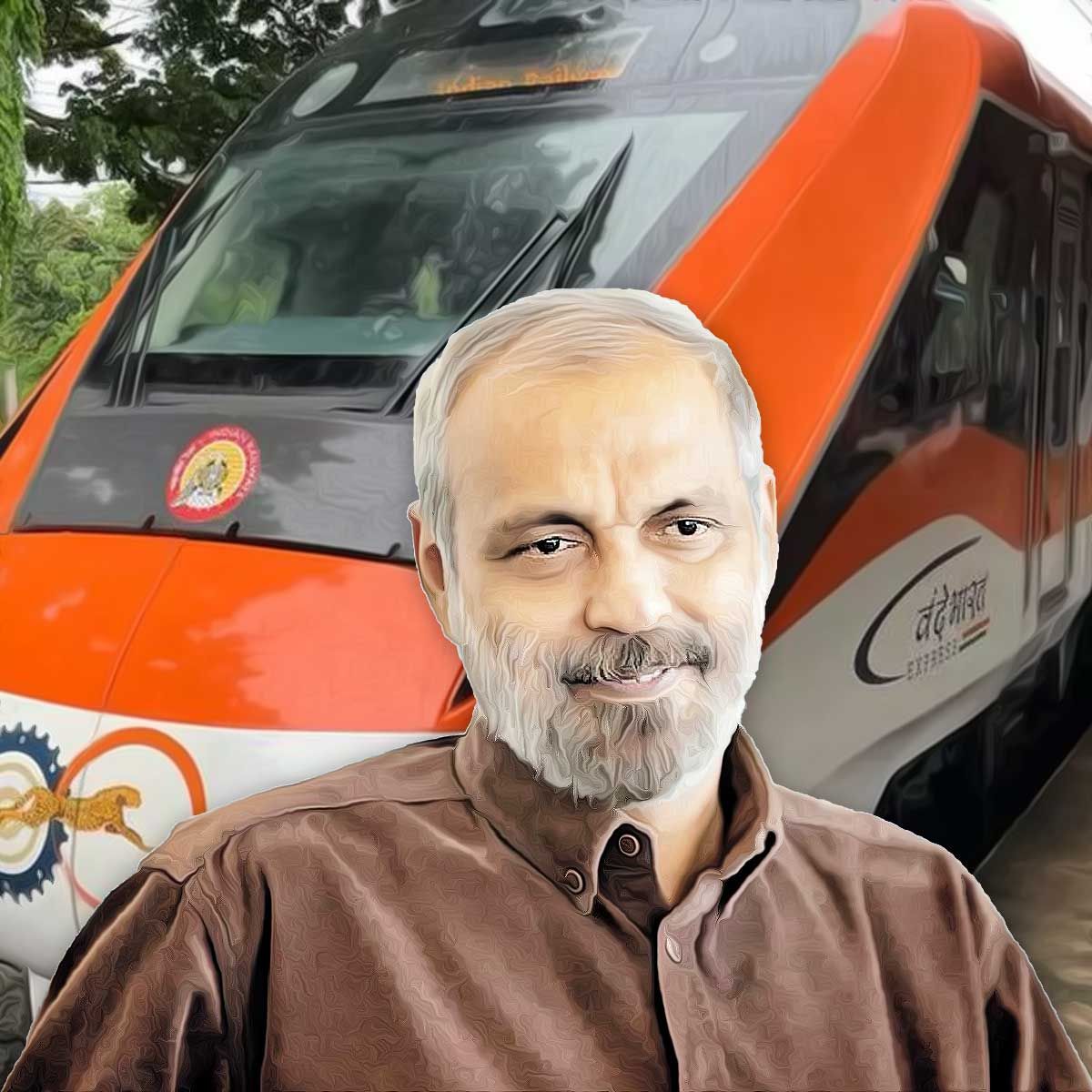More Coverage
Twitter Coverage
Satyaagrah
Written on
Satyaagrah
Written on
Satyaagrah
Written on
Satyaagrah
Written on
Satyaagrah
Written on
JOIN SATYAAGRAH SOCIAL MEDIA
"Quiet heroes, roaring legacies": An unknown hero behind the Vande Bharat Express, Sudhanshu Mani, amidst hurdles and bureaucracy, he penned India's rail legacy, as we applaud innovation, let's honor the man who transformed India's rail journey

In the grand tapestry of India's railway history, the Vande Bharat trains shine as gleaming threads of modernity, innovation, and indigenization. As these trains navigate the vast terrain of India, there's a silent, steadfast force propelling them, a force that often remains unseen, uncelebrated. That force is Sudhanshu Mani.
The journey of the Vande Bharat trains, while evident in their sleek designs and impeccable performance, is intricately interwoven with Mani's own life journey. As a multidisciplinary engineer with an unwavering vision, Mani not only spearheaded the creation of these marvels but also imprinted upon them his ethos of hard work, perseverance, and unyielding dedication.
Despite the numerous challenges that presented themselves – from bureaucratic hurdles to time constraints – Mani remained undeterred. For him, the Vande Bharat project wasn't just about engineering a train; it was about engineering a legacy for India. A legacy of self-reliance, innovation, and pushing the boundaries of what's possible.
Today, as the Vande Bharat trains stand as a testament to India's technological prowess, let's also remember and salute the spirit of Sudhanshu Mani – the man who dreamt, dared, and delivered, proving that with passion and purpose, even the most ambitious dreams can be transformed into reality.
The Indian Railways has been a testament to India's growth and technological evolution. However, behind every success story, there lies an unsung hero. In the tale of the Vande Bharat Express, that hero is none other than Sudhanshu Mani.
In the vast canvas of Indian Railways, Mani’s legacy spans several crucial projects. Yet, his pinnacle of acclaim was achieved as the General Manager at Chennai's Integral Coach Factory (ICF). It was in this esteemed role that he oversaw the celebrated Vande Bharat Express project, nurturing it from mere inception to triumphant completion.
Mani's dedication was nothing short of remarkable. With a looming deadline set by his imminent retirement in December 2018, he didn't just oversee the project; he raced against time. The stakes were high, and the challenge was daunting. (Photos: Special Arrangement)
A significant chapter in India's railway chronicle, the train initially christened 'Train18', would later receive the honor of being named the Vande Bharat Express. This wasn’t just another train. It heralded a new era, standing proud as the country's first indigenously built semi-high-speed marvel.
Reflecting on his journey, Mani’s tenure as the General Manager of ICF, Chennai, from August 2016 until December 2018, wasn't just about position or title. It was about passion, vision, and an unyielding commitment to excellence.
Sudhanshu Mani's decision to join ICF Chennai wasn’t just a matter of filling a vacancy. It was a conscious choice, driven by ambition and an unwavering commitment. "I wasn't just stepping into a role; I was embracing an opportunity," Sudhanshu reminisces. "I joined ICF Chennai by choice, and was fortunate to lead an incredibly creative team. Together, we gave life to a shared vision."
As decades passed, trains, an iconic symbol of India's progress, had undergone merely superficial changes. From the fiery red to the calming blue, their appearance altered, but their boxy, cumbersome design persisted. Sudhanshu and his team aspired for more than just a paint job. They dreamed of a train that wasn't just swift but also boasted a modern aesthetic appeal. "We weren't looking to follow legacy. We wanted to create one," Sudhanshu reflects.
This dream reached its zenith with the unveiling of Train 18. As the nation watched in awe, this indigenous marvel, capable of astounding speeds of up to 180/160 km/h, rolled out, a testament to the tenacity and innovation of the Integral Coach Factory.
"The Vande Bharat Express isn’t just a train. It’s an emblem of India’s prowess, capturing the nation’s imagination," Sudhanshu remarks with pride. It wasn’t just about speed or aesthetics. It was the spirit of India, materializing for the first time as a rolling stock project, conceptualized and constructed entirely on Indian soil.
However, every journey has its share of anecdotes, and Sudhanshu's tenure at ICF was no different. He recounts an episode from the initial days at ICF. Engrossed in inspecting the sliding door mechanics of an EMU with his team, the day had been like any other. But as dusk approached and Sudhanshu prepared to leave, a serendipitous encounter left an indelible mark on him.
A Mysterious Messenger and a Dream Realized
In the vast complex of ICF, Chennai, filled with the daily hum of machinery and the constant movement of workers, Sudhanshu's encounter with an elderly gentleman was nothing short of fateful. This seemingly retiring soul, who bore the weight of years of service in his posture, approached Sudhanshu with a clear message.
This enigmatic figure handed him a sketched vision on paper and, with an urgency in a blended tongue of Tamil and English, he said, "Your job is to make a sleek, very high-speed train. What you were doing inside is not your job. You have the capacity, power, means and vision to build a train for India. Try to do it." Then, as mysteriously as he appeared, he disappeared into the vastness of the factory, leaving Sudhanshu pondering his words.
The profoundness of this interaction wasn't lost on Sudhanshu. He desperately tried to find this mysterious man in the subsequent months. But with no vivid description and having unfortunately misplaced the invaluable sketch, his endeavors remained fruitless. "It felt as if he was a guardian spirit of the railways, urging me forward," Sudhanshu muses. Although the face eluded recognition, the memory found its way into Sudhanshu's book, 'My Train 18 Story'. "I wish I could have found him once more, to show him the realized dream and to thank him," he expresses.
However, this journey wasn't just about mysterious nudges; it was about overcoming challenges and dispelling doubts. When the audacious dream of the Vande Bharat Express was first envisioned, many were skeptical. Facing a sea of uncertainty and the daunting question, 'Can we do it?' Sudhanshu stood as a beacon of hope and confidence. "I told the team, 'Yes, we can, with dreams in our eyes and hard work in our hearts.' My faith wasn't just in the project but in the collective might and passion of the team," Sudhanshu asserts.
With unwavering determination, the next step was securing the official green light. Sudhanshu's confidence shone again, reassuring his team amidst the echoing skepticism. The journey of the Vande Bharat Express wasn’t just about reaching destinations at high speed. It was a testament to tenacity, vision, and the relentless human spirit.
|
Convincing the Gatekeepers: Mani’s Unyielding Determination
Sudhanshu Mani's pursuit of realizing the dream of Vande Bharat Express was anything but smooth. As he sat down with Dainik Bhaskar for an intimate tete-a-tete, he vividly recounted the layers of skepticism and bureaucratic hurdles that stood tall in his way.
He opened up, "Ministry officials doubted our team's claims to develop a world-class train at one-third cost; they thought our claim was just a publicity stunt." Such doubts are perhaps understandable, given the magnitude and ambition of the project. However, for Mani, this was not a mere claim; it was a genuine belief in the capabilities of the ICF team.
Desperation often leads to audacious actions. In a defining moment, an exhausted Mani sought an audience with the then Chairman of the Railway Board. Pleading his case, he stated, “Exhausted, I approached the then Chairman of the Railway Board. I pitched Train 18 to him, and even assured that the ICF team can manufacture a world-class train at one-third the cost of importing such a train from abroad”.
Time was ticking, and with the Chairman nearing his retirement, Mani made a daring promise. He claimed the train would be ready before the Chairman's retirement, allowing him the honor of inaugurating it. It was a white lie, but a necessary one. "The urgency of the moment demanded drastic measures," Mani justified.
|
But sometimes, even the most passionate pleas fall on deaf ears. Despite the passionate pitch, the approval was withheld. However, Mani's determination was unparalleled. In an act of sheer desperation and commitment, he caught hold of the official's feet – a traditional gesture symbolizing earnestness in Indian culture. He vowed, "Give me sanction for two trains and I will do it at one-third the cost." His heartfelt plea won him the much-needed budget of Rs 200 crore.
Yet, with the budget in hand, a new specter of doubt loomed. There was the very real fear of failure. What if they couldn't deliver? As a seasoned leader, Sudhanshu knew how to keep his team motivated. With a reassuring demeanor, he told them, "If we succeed, the credit is all yours. If we fail, I'm the one retiring soon, so what's the worst that can happen to me?"
Mani's story is more than a testament to the power of perseverance. It's a tale of belief, leadership, and the spirit of innovation.
The green signal was finally illuminated, marking the beginning of a thrilling journey to revolutionize Indian Railways. As soon as permission was granted, the entire team at ICF sprang into action with unmatched zeal. Given the project's significance, the team felt it deserved a unique identifier. Thus, "Train 18" was christened, symbolizing the ambitious 18-month timeline the team had set for themselves. Against international standards, this was a mammoth task; what they achieved in 18 months would have taken a whopping three years abroad. This spirit of determination and innovation culminated in what is now celebrated as the "Vande Bharat Express".
Under Sudhanshu Mani's visionary leadership, the Integral Coach Factory, already recognized as a global giant in coach manufacturing, accomplished the remarkable feat of producing not one, but two Vande Bharat Express trains by the time of his retirement. Mani's optimistic foresight sees as many as 300 of these modern marvels gracing the Indian tracks in the upcoming 4-5 years.
|
Sudhanshu's book chronicling the journey of Train 18 stands as a testament to his dedication and the groundbreaking endeavors of the entire team.
However, the journey was not devoid of uncertainties. With the clock relentlessly ticking towards Sudhanshu's impending retirement in December 2018, and the project's initiation in April 2017, the team faced a daunting deadline. They had approximately 35-40 weeks to bring the Vande Bharat Express from blueprints to reality. Alongside the pressing timeline, looming was the apprehension regarding a possible leadership shift post-December, which could introduce unforeseen changes to the project's trajectory.
Addressing these valid concerns, Sudhanshu emboldened his team with faith in their capabilities. He proclaimed, "We Indians are hard workers. I'm confident that my team can work around the clock and complete this before December 2018." It was this very determination and sense of purpose that lent Train 18 its distinctive name.
In an exemplary display of dedication and teamwork, the first Vande Bharat Express, previously dubbed Train18, was ready to roll by October 27, 2018. The pride was palpable as the train was unveiled, not just as a testament to technological advancement, but as a symbol of collective effort and tenacity, much to the joy of ICF Chennai employees and their families.
As the first Vande Bharat Express roared through the Indian tracks, achieving a record speed of over 180 km/hr in December's initial testing phase, it heralded a new era for the Indian Railways. This groundbreaking accomplishment, however, was just one facet of Sudhanshu Mani's illustrious career. He has always been an advocate for change and progression, often swimming against the tide to realize his vision.
One of the first things that struck Sudhanshu upon his entry into the Railways was its archaic and feudal work culture. Rather than assimilate, he chose to challenge this norm. Symbolizing this rebellion, he traded the conventional officer's briefcase for a modest bag, aiming to disconnect from the longstanding feudal roots. Sudhanshu's ideology was simple yet profound: breaking away from tradition to pave the way for modernization.
This perspective was not restricted to mere symbolism. Sudhanshu steered a series of transformative initiatives during his tenure. Mechanized cleaning of stations and the introduction of airport-style trolleys were just a few of the changes he championed, enhancing the traveler's experience and bringing the railways a step closer to international standards.
Art was another domain close to Sudhanshu's heart. To blend art with the daily humdrum of the railways, he orchestrated the SAFAR (Support & Apprentice for Art & Railway) art movement. This initiative, evident in the vivid artwork adorning Bangalore railway station, injected color, life, and emotion into the otherwise mundane railway backdrop. He passionately believed that art serves as a bridge, fostering human connections and grounding individuals, saying, "Art in any form can teach us about life, human interaction, and achieving a good work-life balance."
Delving into Sudhanshu's background, it becomes evident that railways are an integral part of his heritage. Hailing from Gorakhpur, a city nestled in eastern Uttar Pradesh, the railways' influence was present since his early days. His father, a stalwart of the Indian Railways, served the nation until his retirement as the Assistant General Manager of the North-Eastern Railway. The legacy and dedication to the railways, it seems, run deep in the Mani family. At 65, Sudhanshu Mani continues to inspire many with his innovative spirit, perseverance, and unwavering commitment to excellence.
Sudhanshu Mani: Rooted in Family and Traditions
Amid the whirlwind of professional accomplishments and railroad innovations, at the core of Sudhanshu Mani's life lies a close-knit family that shaped his principles and worldview.
Growing up, Sudhanshu witnessed firsthand the sacrifices a parent makes for their children. His mother, qualified and skilled enough to become a Hindi lecturer, instead chose to dedicate her years to nurturing her children. The commitment and devotion she demonstrated would have a lasting impact on Sudhanshu, instilling in him the values of sacrifice and commitment.
Sudhanshu's formative years were marked by a nomadic lifestyle, constantly on the move due to his father's transferable job. He reminisces, "The railway colonies were our transient homes. Every few years, we had a new address, a new school." Despite the constant flux, these colonies provided stability. They were thriving communities, buzzing with cultural clubs, sports events, and community activities. This vibrant environment gave Sudhanshu and his siblings a unique upbringing, enriched with diverse experiences and friends from across the country.
His academic journey saw him completing his school education from the prestigious Colvin Taluqdars' College in Lucknow in 1975. From there, he entered IIT Kanpur, initially choosing Metallurgical Engineering. However, destiny had a different track laid out for him. Dissatisfied with his choice at IIT, Sudhanshu turned his eyes to the Special Class Railway Apprentice (SCRA) program, a celebrated gateway for aspiring mechanical engineers to step into the world of railways. Clearing this challenging exam, Sudhanshu was onboarded into the program in 1976.
Sudhanshu's graduation from the program in 1981 marked the official beginning of his dedicated service to the railways. Two years of probation later, in 1983, he found himself amidst the bustling rail yards of Andal, Asansol in West Bengal as the Assistant Works Manager.
However, beyond the clamor of the railways, lies a tranquil family life. His wife, Anupama S. Mani, carved her niche first as a journalist and later transitioned to academia. Her dedication to family mirrored that of Sudhanshu's mother as she chose to devote her time to their son, Sarang, during his formative years. Sarang, a testament to his parents' commitment, pursued his higher education in the US and now works with JP Morgan in New York.
For Sudhanshu, while the railways were an undeniable passion, it was family that provided the anchor, grounding him amid the challenges and triumphs of his illustrious career.
He looks up to several iconic figures like the 'People's President' APJ Abdul Kalam and the 'Metro Man' E. Sreedharan. Dr. Kalam, a luminary known for his undying patriotism, simplicity, and purpose-driven life, deeply resonated with Sudhanshu. "Dr. Kalam's journey is a testament to the power of dreams backed by hard work. Every moment of his life is a lesson in perseverance, dedication, and humility," Sudhanshu reflects.
Sreedharan's meticulous planning, vision, and flawless execution of the Konkan Railway and Metro projects have always been a source of admiration for Sudhanshu. His genuine appreciation for Sreedharan's integrity and hard work shines through when he reminisces about meeting the 'Metro Man' after the success of his train project.
While railways have been a significant part of Sudhanshu's life, his post-retirement phase has been anything but monotonous. His diverse interests have seen him wear multiple hats - from an author and art enthusiast to an inspirational speaker.
His literary pursuits have borne fruit in the form of six enriching books, each of them providing an insightful glimpse into the world of railways, art, and the environment. Titles like "Art and Railways - A Bangalore Saga" and "Greening of a Factory - Verdant Makeover of a Factory and its Habitat" hint at the vast spectrum of his interests and his keen observation skills. Always one to keep his creative juices flowing, Sudhanshu is already in the process of penning down two more books.
With a career as sparkling as his, it's no surprise that Sudhanshu is often invited to deliver lectures, sharing his wealth of experience and wisdom with young minds. Through his talks, he hopes to inspire the next generation to dream big, remain grounded, and relentlessly pursue their passions.
For Sudhanshu Mani, life has been a fulfilling journey, with each chapter brimming with learning, innovation, and the joys of making a difference. As he looks back, he feels gratitude for the icons who inspired him, and as he looks forward, he hopes to continue being a beacon of inspiration for many more.
|
Book Review - The making of a train - A racy tale of beating babudom to roll out Train 18
In the annals of Indian Railways history, Sudhanshu Mani's name will shine bright, not only as a visionary but as a tenacious leader who dared to break the barriers of bureaucracy to achieve a seemingly impossible feat. His book, "My Train 18 Story", provides a riveting inside look at the saga of creating Train 18, India's first indigenous modern train.
With a narrative that's as compelling as the story itself, Mani transports readers into the heart of the action, giving them a front-row seat to the challenges, innovations, and sheer determination that went into the creation of Train 18. But it's not just about the triumphs. Mani doesn’t shy away from showcasing the hurdles – the trials and tribulations, the skepticism, and the challenges posed by the omnipresent bureaucracy.
Bureaucracy in India is often a double-edged sword. While it helps maintain order and procedure, it sometimes hinders innovation and speed. Mani's experience with the 'babus', as the bureaucrats are colloquially referred to in India, paints a picture of the intricate dance between innovation and red tape. The book underscores the point that success in such environments is often determined not just by one's technical acumen but also by one's ability to navigate bureaucratic mazes.
|
Mani's journey isn’t simply a tale of engineering and manufacturing prowess; it's also a reflection of India's tryst with modernity, of how a nation, despite its diverse challenges, dreams big. Train 18 becomes not just a train but a symbol of India's aspirations.
Furthermore, the book transcends its technical underpinnings to become a testament to leadership, teamwork, and perseverance. Mani's storytelling is peppered with quotes, including those from Shakespeare, offering a poetic touch to a technical narrative. He delves deep into various aspects, from public procurement systems and design of rolling stock to manufacturing techniques and train simulations, ensuring that the reader, whether a layman or an expert, remains engaged.
"My Train 18 Story" isn’t just about a train; it's about vision, tenacity, and the relentless pursuit of excellence. Sudhanshu Mani's chronicle is an inspiration for innovators, leaders, and dreamers, urging them to believe, against all odds, that they too can create their own version of Train 18 in their respective fields.
Sudhanshu Mani's book, "My Train 18 Story", is not just a story of India’s first indigenous modern train but also a compelling chronicle of innovation in the face of adversity.
The fact that the entire project was executed without any transfer of technology from a global train manufacturer is a testimony to India's capabilities. For Mani and his team, the Train 18 wasn't just a train; it was a symbol of India's self-reliance and ingenuity. Every nut, bolt, and wire was a silent witness to the dedication of countless individuals who toiled day and night to make this dream a reality.
While the government played its part by effectively utilizing media to galvanize public interest and rally national pride around the project, internal challenges remained. It's poignant to see how, even as the project was celebrated externally, there were detractors within the system. Mani’s narrative sheds light on these internal critics, painting a vivid picture of the struggles and roadblocks the team faced, even as they were building what was to become a hallmark of excellence for the Indian Railways.
The book is not just a recollection but also an introspection. Mani’s reflections on the delays and detractors, even after his retirement, provide a personal touch to an already compelling narrative. His mention of the "venal minds" and the "plots" brewing gives readers an inside look into the complexities and intricacies of managing such a monumental project.
Yet, through all the trials and tribulations, Mani’s optimism remains unshaken. His belief in the project, in the capabilities of his team, and in the future of Train 18 is unwavering. Despite the hitches, he remains hopeful for the future of the train and its larger role in the Indian Railways.
In essence, "My Train 18 Story" is not just a story of a train. It's a story of passion, perseverance, and unyielding belief in a dream. It's about overcoming challenges, both external and internal, and emerging victorious against all odds. Through Sudhanshu Mani’s words, Train 18 becomes not just a feat of engineering but a testament to the indomitable human spirit.
"My Train 18 Story" by Sudhanshu Mani is an enigmatic tale of determination, vision, and the age-old battle between innovation and bureaucracy. What emerges from these pages is not just the story of a train, but the tale of a country at the crossroads of modernity and traditionalism, with the author and his team positioned squarely in the center.
Mani's book gives readers an intimate glimpse into the labyrinth of challenges that innovators often face in India. While the Train 18 project exemplifies the creative prowess of Indian engineers, it also lays bare the frustrations encountered due to red tape and convoluted processes. Mani's recollections of unprecedented clearances and irrelevant questions from officials, which had not been imposed on previous projects, provide a stark portrayal of the hurdles faced by those pushing for progress.
What's riveting about the narrative is that even as Mani dives deep into the technicalities of the train's creation, he doesn't lose sight of the very human drama unfolding around him. The frustrations, the interpersonal dynamics, the internal politics – these elements come alive in the later chapters, giving the book an unexpected twist, transforming it from a technical memoir to a gripping drama of human resilience and perseverance.
Mani's parting words, borrowing from a Persian poet, encapsulate his journey. His silence throughout the book speaks volumes, revealing the trials and tribulations he and his team underwent. However, his closing hint at breaking this silence in a potential sequel, not only promises another insightful read but also serves as a testament to his relentless spirit.
Through the highs and lows, the achievements and setbacks, "My Train 18 Story" stands as a powerful reminder of what can be achieved when determination meets adversity. It's a beacon of hope for all the dreamers and doers who dare to challenge the status quo, despite the odds stacked against them.
 Support Us
Support Us
Satyagraha was born from the heart of our land, with an undying aim to unveil the true essence of Bharat. It seeks to illuminate the hidden tales of our valiant freedom fighters and the rich chronicles that haven't yet sung their complete melody in the mainstream.
While platforms like NDTV and 'The Wire' effortlessly garner funds under the banner of safeguarding democracy, we at Satyagraha walk a different path. Our strength and resonance come from you. In this journey to weave a stronger Bharat, every little contribution amplifies our voice. Let's come together, contribute as you can, and champion the true spirit of our nation.
 |  |  |
| ICICI Bank of Satyaagrah | Razorpay Bank of Satyaagrah | PayPal Bank of Satyaagrah - For International Payments |
If all above doesn't work, then try the LINK below:
Please share the article on other platforms
DISCLAIMER: The author is solely responsible for the views expressed in this article. The author carries the responsibility for citing and/or licensing of images utilized within the text. The website also frequently uses non-commercial images for representational purposes only in line with the article. We are not responsible for the authenticity of such images. If some images have a copyright issue, we request the person/entity to contact us at This email address is being protected from spambots. You need JavaScript enabled to view it. and we will take the necessary actions to resolve the issue.
Related Articles
- "The growth and development of people is the highest calling of leadership": PM Modi flags off 5 Vande Bharat Express Trains From Bhopal in Presence of Railway Minister Ashwini Vaishnaw and CM Shivraj Singh Chouhan, Bihar gets its rist Vande Bharat Train
- "India speaks, Bhashini translates": 'Bhashini', India's AI breakthrough, revolutionizes linguistic inclusivity, and ensuring no citizen is left behind in the digital realm, a beacon for tech innovation, redefining the nation's digital journey
- Konark Chakra - Bharat’s Chariot of Progress at G20 Summit echoes our vibrant journey, a harmonious blend of rich heritage and dynamic innovation, steering the nation towards a bright, inclusive future on the global stage, fuelled by cooperation & harmony
- "हवाई चप्पल से हवाई जहाज का सफर": In 6 years, Modi's UDAN bridges 1.3 crore dreams across 499 routes, turning aspirations to altitude, a narrative of unparalleled connectivity, where the sky isn't just a limit, but a new dawn for India's soaring ambition
- "Being a good neighbor is an art which makes life richer": Sri Lanka designates INR as official currency, President Wickremesinghe's aims to bolster relations and discuss key issues, amidst a history of mutual support during Sri Lanka's economic crisis
- "Beyond gravity, within safety": ISRO's Gaganyaan mission progresses with Drogue Parachute tests, prioritizing astronaut safety, aiming to send a crew to 400 km orbit for 3 days, it utilizes Human Rated LVM3 and comprehensive training in Bengaluru
- "चश्मे बद्दूर": Bulldozers target tall buildings, showrooms, madrasas on illegal land in Akbarnagar after CM Yogi's meet, despite to be 'poor' claims, LDA reveals 72 millionaires to the court, exposing a complex mix of legality and socio-economic dynamics
- "Love over fear, always": From Kashmir's Kulgam, where AK-47s once echoed, 21-year-old Muneeb Amin Bhat shines bright, transitioning from conflict to Apple's Hall of Fame, Kulgam's symbol of evolution, highlighting the triumph of talent over turmoil
- "300 meetings, 200 hours, 15 drafts and the indomitable spirit of 4 diplomats": Discover the untold behind-the-scenes efforts at the monumental G20 Summit in forging a consensus on the Ukraine issue, marking a significant milestone in global diplomacy
- World’s highest tunnel to be built by BRO to connect Himachal Pradesh and Zanskar valley in Union Territory of Ladakh; will ease movement of the Indian Army vehicles: Director-General of BRO, Lt Gen Rajeev Chaudhary
- "A lotus symbolizes purity amidst adversity": Introducing 'Namoh 108', a new variety of special lotus with 108 petals from Lucknow's CSIR-NBRI, it's not just a flower, but a tribute to India's traditions, plus, it blooms longer than other lotuses
- "Innovation is the calling card of the future": Jaldost, a revolutionary airboat by Bengaluru's National Aerospace Laboratories, powers through aquatic weeds, carving the path towards preserving cleaner water bodies, a testament to indigenous innovation
- "Discipline is the bridge between goals and accomplishment": The Dhola Sadiya Bridge (Bhupen Hazarika Setu) connecting Arunachal Pradesh and Assam and reducing 165 km of distance is the longest bridge in India where length of the bridge alone is 9.150 km
- "Create your own miracles; do what you think you cannot do": BRO's Engineering Marvels - Bridging Gaps, Transforming Lives in challenging terrain through crucial road networks, playing a vital role in national security, and fostering socio-economic growth
- "Turning the page from turmoil to tranquility": 4 years since the revocation of Article 370, Jammu & Kashmir emerges from the shadow of conflict, embracing peace, prosperity and an era of unprecedented development, this is the dawn of a new, united Bharat




























